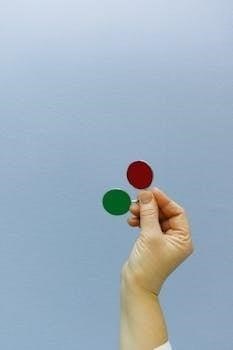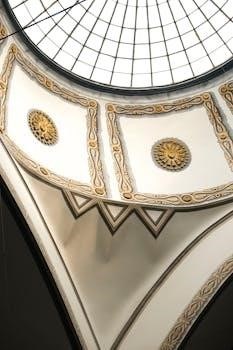
-
By:
- elizabeth
- No comment
parts of a circle worksheet pdf
Parts of a Circle Worksheet PDF⁚ An Overview
A Parts of a Circle Worksheet PDF offers a structured approach to learning circle anatomy. These worksheets typically include diagrams‚ definitions‚ and exercises to reinforce understanding. They cover essential components like radius‚ diameter‚ chord‚ and circumference‚ aiding in geometry skill development.
Identifying Parts of a Circle⁚ Radius‚ Diameter‚ and Center
Identifying the radius‚ diameter‚ and center is fundamental to understanding circle geometry. The radius is a line segment from the center of the circle to any point on its circumference. The diameter‚ conversely‚ is a line segment that passes through the center‚ connecting two points on the circle; it’s twice the length of the radius. Locating the center is crucial‚ as it serves as the reference point for all measurements and calculations within the circle.
Worksheets often provide diagrams where students must pinpoint and label these elements. Activities may include measuring radii and diameters‚ or determining the center given other circle properties. Mastering these concepts is essential for progressing to more complex topics‚ such as calculating circumference and area. Recognizing these parts is the cornerstone of circle geometry.
Understanding Chords‚ Secants‚ and Tangents
Moving beyond the basics‚ understanding chords‚ secants‚ and tangents is essential for a comprehensive grasp of circle geometry. A chord is a line segment whose endpoints both lie on the circle’s circumference. The diameter is actually the longest possible chord in any given circle. A secant‚ meanwhile‚ is a line that intersects the circle at two distinct points‚ extending beyond the circle itself.
A tangent is a line that touches the circle at exactly one point‚ known as the point of tangency. Worksheets dedicated to these elements often involve identifying them in diagrams‚ calculating lengths or angles related to them‚ and understanding their properties. For instance‚ a tangent line is always perpendicular to the radius drawn to the point of tangency. These concepts are vital for solving more complex geometric problems.
Arcs⁚ Major and Minor Arcs Explained
Arcs represent a portion of a circle’s circumference‚ and understanding the distinction between major and minor arcs is crucial. A minor arc is the shorter path between two points on the circle‚ while a major arc is the longer path. The central angle subtended by a minor arc is less than 180 degrees‚ whereas the central angle of a major arc is greater than 180 degrees.
Worksheets often include exercises where students must identify major and minor arcs‚ calculate their degree measures‚ or determine their arc length. Knowing the relationship between the central angle and the intercepted arc is key to solving these problems. For example‚ the arc length is proportional to the central angle‚ and the entire circle represents 360 degrees. These skills are fundamental for further exploration of circle theorems and geometric proofs. Furthermore‚ correctly labeling and differentiating between these arcs is vital.

Worksheet Applications
Worksheets provide practical exercises in identifying circle parts and labeling diagrams‚ offering reinforcement of key concepts. They help students distinguish between radius‚ diameter‚ chord‚ and tangent‚ improving comprehension and retention of geometric principles.
Practice Identifying Circle Parts
Engaging in practical exercises is crucial for solidifying understanding of circle components. Worksheets designed for this purpose typically present various circle diagrams with labeled or unlabeled parts‚ challenging students to correctly identify each element. These exercises often focus on distinguishing between the radius‚ diameter‚ chord‚ secant‚ and tangent‚ ensuring a comprehensive grasp of their definitions and properties.
Furthermore‚ these practice activities may involve matching exercises‚ where students connect the name of a circle part with its corresponding visual representation. True/false questions can also be incorporated to test conceptual understanding and address common misconceptions. By actively participating in these identification tasks‚ students enhance their ability to quickly and accurately recognize circle parts‚ a fundamental skill in geometry. The repetitive nature of these exercises aids in memorization and reinforces the relationships between different components of a circle. These skills are essential for solving more complex geometry problems later on.
Labeling Diagrams for Reinforcement
Labeling diagrams serves as a powerful tool for reinforcing knowledge of circle parts. Worksheets incorporating this method present students with blank or partially labeled circle diagrams‚ requiring them to accurately identify and label various components. This active engagement promotes a deeper understanding of the spatial relationships between the center‚ radius‚ diameter‚ chord‚ tangent‚ secant‚ arc‚ sector‚ and segment.
By physically writing the labels onto the diagram‚ students actively process and internalize the information. This hands-on approach strengthens memory retention and enhances their ability to visualize these concepts. Furthermore‚ labeling exercises can be designed with increasing levels of complexity‚ gradually introducing more challenging scenarios and combinations of circle parts. This progressive learning approach ensures that students develop a solid foundation and can confidently apply their knowledge to solve more complex geometry problems. The visual reinforcement provided by labeling diagrams is particularly beneficial for visual learners‚ making the learning process more effective and engaging.

Educational Resources
A variety of educational resources‚ including printable worksheets‚ are available to aid in learning the parts of a circle. These resources cater to different learning styles and grade levels‚ offering comprehensive support for geometry education.
Worksheets for Grades 5-6
Worksheets designed for grades 5-6 typically focus on introducing fundamental concepts related to the parts of a circle; These worksheets provide students with opportunities to identify and label the radius‚ diameter‚ and center of a circle. They might include basic definitions and simple diagrams to aid comprehension.
Exercises often involve measuring the radius or diameter of given circles and calculating the circumference using these measurements. Some worksheets may also introduce the concept of a chord. The difficulty level is generally kept accessible to ensure that students in this age group can grasp the core ideas without feeling overwhelmed.
These worksheets serve as a foundational step for understanding more complex geometric concepts related to circles in later grades. They aim to build a solid understanding through practice and visual aids.
GCSE Maths Revision Guide
A GCSE Maths Revision Guide focusing on circles will delve into more advanced concepts than introductory worksheets. It would cover not just the basic parts like radius and diameter‚ but also arcs‚ sectors‚ segments‚ tangents‚ and secants. The guide would include step-by-step examples of how to calculate arc length and sector area‚ often involving formulas that require a deeper understanding of circle properties.
Exam-style questions are a key component‚ challenging students to apply their knowledge in problem-solving scenarios. These questions may require combining circle theorems with other geometric principles. A good revision guide will also provide clear explanations of circle theorems and their applications.
Free worksheets accompanying the guide would offer opportunities for practice and reinforcement. These resources ensure students are well-prepared for their GCSE maths exams.

Interactive Activities
Interactive activities enhance learning about circle parts. Games and digital tools can make identifying radius‚ diameter‚ and other elements engaging. These activities often provide immediate feedback‚ reinforcing understanding through playful exploration and visual aids.
Games for Learning Circle Parts
Engaging games offer a dynamic and interactive approach to mastering the parts of a circle. These games often transform abstract concepts into visual and tactile experiences‚ making learning both enjoyable and effective. From matching games that pair definitions with diagrams to interactive labeling exercises‚ these activities cater to diverse learning styles.
Many online platforms feature games specifically designed to reinforce understanding of radius‚ diameter‚ chord‚ tangent‚ secant‚ arc‚ sector‚ and segment. These games often incorporate challenges‚ rewards‚ and competition to motivate students and encourage active participation. Some games even simulate real-world applications‚ allowing students to visualize how circle parts are used in engineering‚ architecture‚ and design.
Furthermore‚ teachers can create their own games using readily available materials and resources. For instance‚ a simple “circle part scavenger hunt” can be conducted in the classroom‚ where students identify and label different parts of circles displayed on posters or worksheets. These hands-on activities promote collaboration‚ critical thinking‚ and problem-solving skills‚ while solidifying knowledge of circle anatomy. Games offer an alternative to traditional worksheets‚ providing a fun and memorable way to learn.

Circle Anatomy⁚ Diameter‚ Radius‚ and Center
Understanding the fundamental components of a circle – the diameter‚ radius‚ and center – is crucial for grasping basic geometry. The center serves as the circle’s central point‚ equidistant from all points on the circumference. The radius is any line segment that connects the center to a point on the circle’s edge. The diameter‚ on the other hand‚ is a line segment that passes through the center and connects two points on the circle‚ effectively being twice the length of the radius.
Visual aids‚ such as labeled diagrams and interactive worksheets‚ significantly enhance comprehension of these concepts. Worksheets often feature exercises that require students to identify‚ measure‚ and calculate the radius and diameter of various circles. These exercises reinforce the relationship between the radius and diameter‚ emphasizing that d = 2r.
Furthermore‚ exploring real-world examples‚ such as wheels‚ coins‚ and circular structures‚ helps students appreciate the practical applications of circle anatomy. Understanding these core components lays the foundation for more advanced topics‚ including circumference‚ area‚ and the properties of chords‚ tangents‚ and secants. Properly grasping the relationship between these elements is key to solving geometry problems.